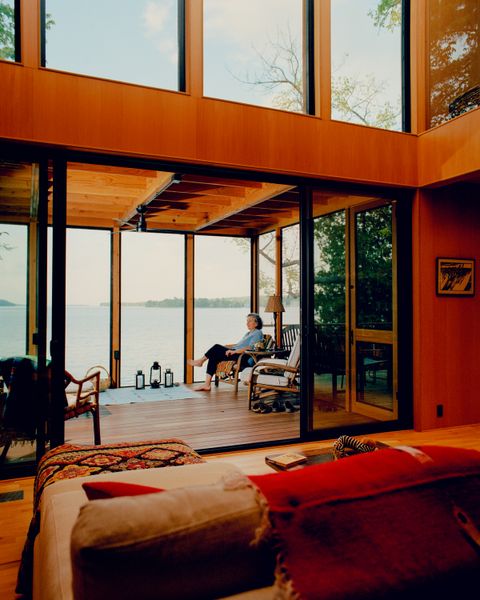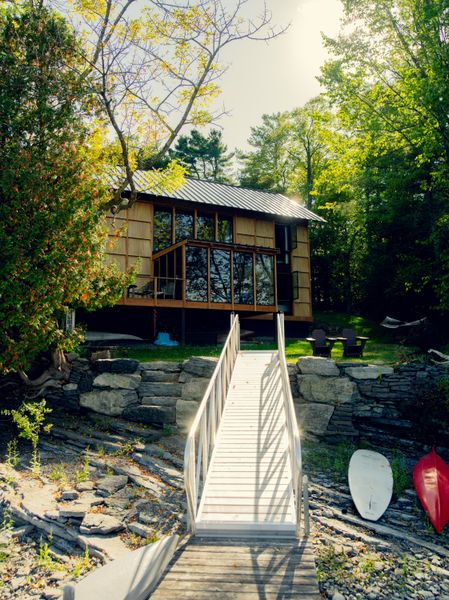Burdened by kitsch and ancestral expectations, my parents rebuilt their camp in a contemporary style that frames what’s worth holding on to.
Modern architecture can be a break with the past, an opportunity to shed some of the cultural baggage of traditional styles. When my parents, Sylvia Balderrama and John Morley, were rebuilding their decaying family Adirondack cabin, going modern meant breaking free of both local clichés and some of the strictures of my somewhat severe ancestors. My great-grandfather, a semi-itinerant Methodist minister, originally followed a church leader to summer in a rural area by Lake Champlain, where a group of fellow ministers camped in small cabins that were less like shore resorts and more like monastic retreats—no indoor bathrooms, hot water, or any other decadent amenities. Even interior doors were frowned upon because of what naughty hijinks could happen behind them. (Playing cards was forbidden, to say nothing of more mature activities.)

My family has been spending summers on a stretch of the Lake Champlain shore since my great-grandfather, a minister, followed Methodist theologian Georgia Harkness there. (She once called the area “one of the most beautiful spots on the face of the earth.”) But my parents’ old camp, one of a couple my grandparents passed to their kids, was sliding into ruin. So, my parents, Sylvia Balderrama and John Morley, turned to Henry Ng and Jacob Esocoff of New York architecture firm Ideas of Order, who designed a replacement in a contemporary style that respected the local history. The living space opens onto the porch, where Sylvia sits on a blanket she crocheted that covers a chair from a nearby secondhand store. The windows and doors are from Marvin, and the ceiling fan is from Minka-Aire.
Photo: Will Pippin
But after years of ad hoc additions, upgrades, and repairs, my parents’ cabin had sinking floors, leaning door frames, and innumerable cracks for creepy crawlies to climb inside. Having endured enough rustic charm, and thanks to some inherited money from my late grandfather, a professor, they were ready for a sleeker house that wouldn’t collect so much dust and dirt and might, perhaps, have doors. Architects Jacob Esocoff and Henry Ng of New York firm Ideas of Order and contractor Mike Sherman of Bessboro Builders created for them what is on one hand a pretty standard cabin—a wooden box covered by a pitched metal roof—and on the other is an anomaly clad in oversize plywood shingles and filled with sleek surfaces that hide hardware and details. Not only are there doors, but elegantly detailed ones with hidden hinges. Mexican alebrijes (animal figurines) and textiles weave in my mother’s heritage, and Japanese pottery and paintings bring in splashes of my father’s history of growing up in Japan. A modern house, my parents learned, doesn’t have to be totally detached from traditions. Instead, it can learn from the past and frame new traditions worth keeping.

Plywood mega-shingles cover much of the facade, and large windows let in views on the lake side.
Photo: Will Pippin

Photo: Will Pippin
See the full story on Dwell.com: Go Modern or Traditional? My Family’s Adirondack Cabin Proves You Don’t Have to Pick
Related stories:



